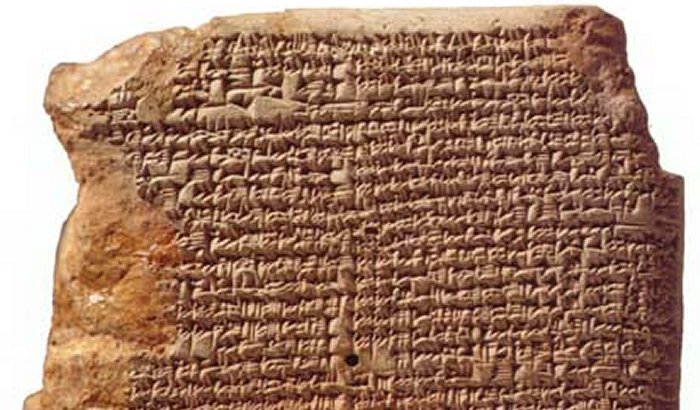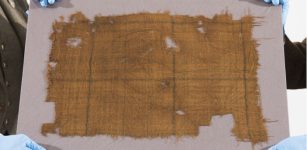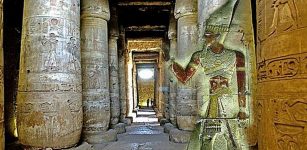MUL.APIN Tablets: Babylonian Knowledge Of Astronomy And Astrology Recorded In Cuneiform Writing
A. Sutherland - AncientPages.com - Systematic observations of the sky were carried out by Babylonians living in southern Mesopotamia in the middle of the third millennium BC.
 MUL.APIN, a Babylonian compendium that deals with many diverse aspects of Babylonian astronomy and astrology. source
MUL.APIN, a Babylonian compendium that deals with many diverse aspects of Babylonian astronomy and astrology. source
The result of these observations defined the concept of the ecliptic and its division into twelve parts, along which they placed twelve signs of the Zodiac. The MUL.APIN cuneiform tablets - the essential source of Babylonian astronomy - represent a set of ancient astronomical records that are believed to be forerunners of the present-day zodiac.
At the time of their introduction, they coincided with constellations with the same names. The tablets were created in Babylon around 687 BC and contained approximately 200 astronomical observations, including measurements related to several constellations.
Long-Lasting Debate On MUL.APIN Cuneiform Tablets
However, many archaeologists believe they are only transcriptions of much earlier records of astronomical observations made by Assyrian astronomers, who observed their sky about 2,300 BC.
The date of the origin of these observations has been disputed for a longer time.
The earliest copies were recovered from the royal library of the Assyrian King Assurbanipal (667-629 BC) in Nineveh and also from Assur.
Now, the majority of scholars believe that the MULAPIN text was originally compiled around 1000 BC, while the latest copies date back to around 300 BC.
The text on the tablets corresponds to the first constellation of the year, MULAPIN "The Plough," which is identified with the double star in the constellation of Andromeda, about 350 light-years from the Earth, known as Triangulum plus Gamma Andromedae. Today we can quickly locate these bright stars in the sky because they form the Big Dipper.
Further, the text lists the names of 66 stars and constellations and further gives a number of indications, such as rising, setting, and culmination dates, that help to map out the basic structure of the Babylonian star map.
When Bradley Schaefer, an astrophysicist at Louisiana State University in Baton Rouge, studied the MUL.APIN tablets, he calculated that the observations date back to 1,370 BC, give or take a century. The observations include the day each year that certain constellations first appeared in the dawn sky and were recorded in the region of Assur.
However, these dates change over the millennia because of a tiny wobble in the Earth's axis.
Small Tablets Of Great Importance
The text covers two MUL.APIN tablets, and possibly a third additional one, which still remains unrecovered.
The first tablet (8.4 centimeters high incised with miniature cuneiform) is the most important resource for any potential reconstruction of the Babylonian star map as its various sections locate the constellations in relation to each other and to the calendar.
All the major stars and constellations are listed and organized into three broad divisions according to celestial latitude assigning each star to three paths:
The first is the northern path of Enlil, containing 33 stars or constellations; the second is the equatorial path of Anu, containing 23 stars or constellations.
The third one is the southern path of Ea ("Whose House Is Water"), widely known as Enki, the Sumerian god of water, knowledge, mischief, crafts, creation, and one of the Anunnaki. The path of Enki contains 15 stars or constellations.
The heliacal rising dates of 34 stars and constellations are given according to the 360-day 'ideal' calendar year.
In the MUL.APIN tablets, an 'ideal' year composed of 12 'ideal' months, each of which was composed of an 'ideal' 30 days, even though the Babylonians used a lunisolar calendar, indicating both the Moon phase and the time of the solar year.
The second MUL.APIN tablet deals with the Babylonian methods and procedures to regulate the calendar and predict the movements of the sun, moon, and planets.
It is believed that there was also the third tablet (yet undiscovered=), and this one most probably explained celestial (astrological) omens.
Written by - A. Sutherland - AncientPages.com Senior Staff Writer
Copyright © AncientPages.com All rights reserved. This material may not be published, broadcast, rewritten or redistributed in whole or part without the express written permission of AncientPages.com
Expand for referencesReferences:
Hunger H. The Babylonian Astronomical Compendium MUL.APIN
Pannekoek A. A History of Astronomy
Rochberg F. Before Nature: Cuneiform Knowledge and the History of Science
More From Ancient Pages
-
 Unexplained Teleportation Cases Of People – Dangerous Fog – Part 2
Ancient Mysteries | Oct 2, 2019
Unexplained Teleportation Cases Of People – Dangerous Fog – Part 2
Ancient Mysteries | Oct 2, 2019 -
 Great Viking Fortresses Built By King Harald Bluetooth
Featured Stories | Dec 12, 2022
Great Viking Fortresses Built By King Harald Bluetooth
Featured Stories | Dec 12, 2022 -
 Mysterious Havering Hoard – Largest Ever Bronze Age Hoard Discovered In London
Archaeology | Oct 21, 2019
Mysterious Havering Hoard – Largest Ever Bronze Age Hoard Discovered In London
Archaeology | Oct 21, 2019 -
 Artificial Intelligence Recreates Pompeii’s Ruined Ancient Masterpieces
Archaeology | Jul 8, 2023
Artificial Intelligence Recreates Pompeii’s Ruined Ancient Masterpieces
Archaeology | Jul 8, 2023 -
 Danish Royal Sunken Ship Sheds Light On Psychological Warfare In The Middle Ages
Archaeology | Apr 3, 2017
Danish Royal Sunken Ship Sheds Light On Psychological Warfare In The Middle Ages
Archaeology | Apr 3, 2017 -
 Eurasian Horse Riders Played Ball Games 3,000 Years Ago – Leather Balls Found In Graves Reveal
Archaeology | Oct 12, 2020
Eurasian Horse Riders Played Ball Games 3,000 Years Ago – Leather Balls Found In Graves Reveal
Archaeology | Oct 12, 2020 -
 Mystery Of Zendan-e Eskandar – Alexander The Great’s Prison
Featured Stories | Oct 14, 2020
Mystery Of Zendan-e Eskandar – Alexander The Great’s Prison
Featured Stories | Oct 14, 2020 -
 Scientists Argue Over The Mysterious Void Discovered Inside The Great Pyramid Of Giza
Archaeology | Nov 8, 2017
Scientists Argue Over The Mysterious Void Discovered Inside The Great Pyramid Of Giza
Archaeology | Nov 8, 2017 -
 Scotland’s Oldest Tartan On Display For The First Time!
Artifacts | Apr 6, 2023
Scotland’s Oldest Tartan On Display For The First Time!
Artifacts | Apr 6, 2023 -
 Remains Of An Ancient Seaport In Asini, Greece Discovered By Underwater Archaeologists
Archaeology | Mar 12, 2025
Remains Of An Ancient Seaport In Asini, Greece Discovered By Underwater Archaeologists
Archaeology | Mar 12, 2025 -
 Abydos: One Of The Most Important Cities Of Ancient Egypt
Civilizations | Jul 15, 2016
Abydos: One Of The Most Important Cities Of Ancient Egypt
Civilizations | Jul 15, 2016 -
 4,500-Year-Old Ramp Might Explain How Huge Stones Were Transported To Great Pyramids’ Building Site
Archaeology | Nov 9, 2018
4,500-Year-Old Ramp Might Explain How Huge Stones Were Transported To Great Pyramids’ Building Site
Archaeology | Nov 9, 2018 -
 Viking Cemetery In Lutomiersk And DNA May Solve The Mystery Of Norse Warriors In Central Poland
Vikings | Jan 7, 2025
Viking Cemetery In Lutomiersk And DNA May Solve The Mystery Of Norse Warriors In Central Poland
Vikings | Jan 7, 2025 -
 The Magnificent Yule Goat In Gävle, Sweden Has Finally Arrived
Christmas Traditions | Dec 2, 2024
The Magnificent Yule Goat In Gävle, Sweden Has Finally Arrived
Christmas Traditions | Dec 2, 2024 -
 Pandavleni Buddhist Caves: Sculptures, Inscriptions And Sophisticated Water Management System
Civilizations | Dec 8, 2016
Pandavleni Buddhist Caves: Sculptures, Inscriptions And Sophisticated Water Management System
Civilizations | Dec 8, 2016 -
 Celtic Valhalla And Sacred Wells – Magic Of Invisible Worlds
Celtic Mythology | Nov 17, 2021
Celtic Valhalla And Sacred Wells – Magic Of Invisible Worlds
Celtic Mythology | Nov 17, 2021 -
 One Of Egypt’s Oldest Christian Churches Discovered By Polish Archaeologists
Archaeology | May 31, 2019
One Of Egypt’s Oldest Christian Churches Discovered By Polish Archaeologists
Archaeology | May 31, 2019 -
 Unique Belongings Of Bronze Age Warrior Offer Evidence Of Massive Violent Conflict In Europe
Archaeology | Oct 18, 2019
Unique Belongings Of Bronze Age Warrior Offer Evidence Of Massive Violent Conflict In Europe
Archaeology | Oct 18, 2019 -
 First Crusade Was Launched In 1095
Ancient History Facts | Jun 19, 2018
First Crusade Was Launched In 1095
Ancient History Facts | Jun 19, 2018 -
 Saraswati – Hindu Goddess Of Knowledge, Learning And Vedic Symbol Of Speech, Vach
Featured Stories | Jun 23, 2021
Saraswati – Hindu Goddess Of Knowledge, Learning And Vedic Symbol Of Speech, Vach
Featured Stories | Jun 23, 2021

